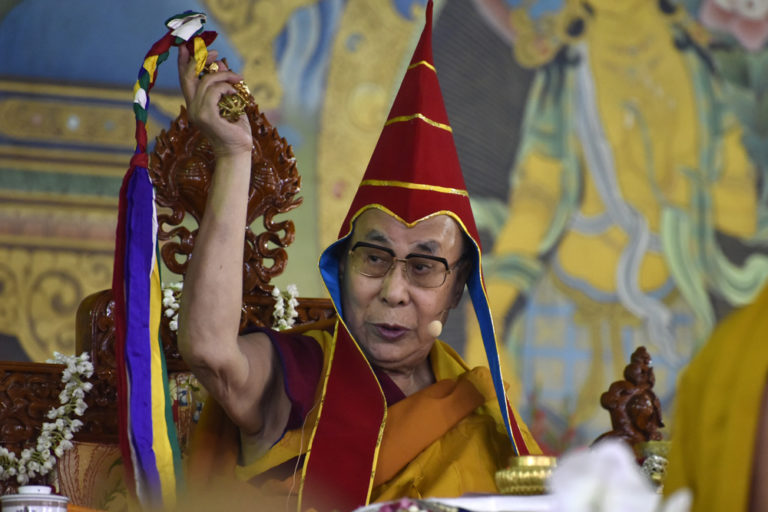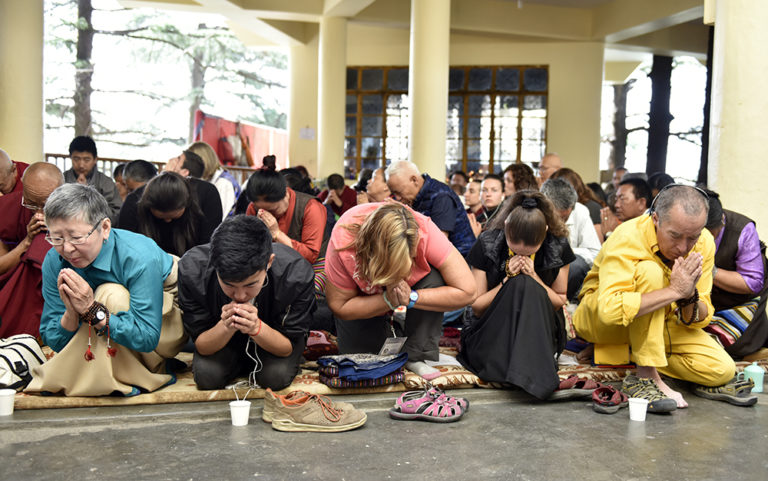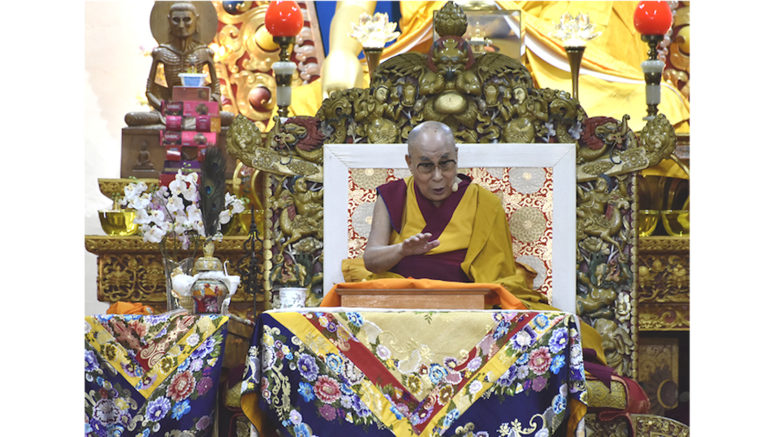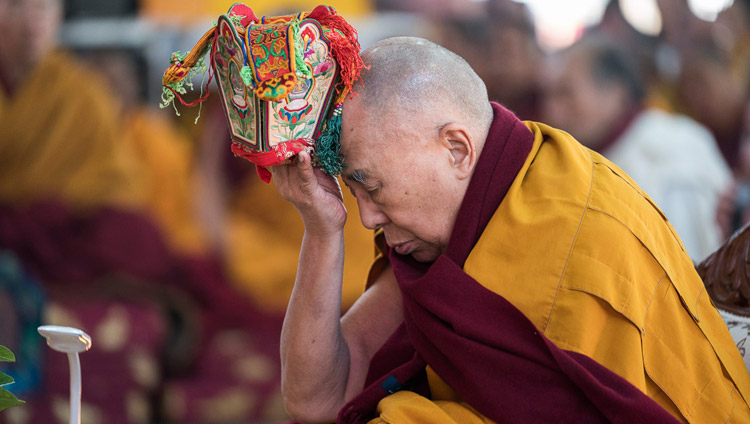During the holiest festival of Tibetan Buddhism (Saka Dawa), people tend to tread the meritorious path and in that pursuit become vegetarian for the whole month and don the generosity hat in giving alms to the poor.
On the first day of Saka Dawa, devotees in and around Dharamsala were lucky as His Holiness the Dalai Lama conferred a Wang the Avalokiteshvara Six-Syllable Empowerment at Tsuglagkhang. As the photo editor for DIIR, I spent the morning in the temple to capture some candid shots.
Unexpectedly, I bumped into an acquaintance, who has for a long time been serving as a security personnel of His Holiness the Dalai Lama. He asked me a question that kept me thinking. He asked me about the significance of Wang, the different types of Wang and difference between a ‘Wang’ and a ‘Jenang’. I had a vague knowledge about it all and know of a slight difference between the two, going by the terminology but lacked a fuller understanding of the difference.
After the conferment of the Wang, I came back to my office to file the photos. But the questions lingered around. Coincidently a colleague of mine who has been watching the conferment of Wang live on a Facebook page of Dalai Lama asked me the same question. This made me learn the meaning, significance and the differences.
I did my homework and looked up various sources and even spoke to translators and Geshes to get further knowledge on the differences.

His-Holiness the Dalai Lama confers Hayagriva initiation at Sera Je courtyard to over 10000 Tibetan and non Tibetan devotees 20 December 2017. Photo/Tenzin Phende/DIIR
Wang (དབང་), meaning empowerment, is given to introduce a practitioner to a specific esoteric Buddhist practice. Empowerment is considered to be the tool that ripens or matures (སྨིན་བྱེད་) the mindset of a practitioner for spiritual practice. There are many kinds of Wang but one can generally place them into one of two categories. One is Jenang (རྗེས་གནང་) literally means subsequent permission and this particular initiation is targeted or meant for those who have already received the full initiation before. ‘Je’ in Tibetan means ‘after’ and ‘Nang’ means ‘permission’ which is referring to the permission that you receive from the Guru to practice and visualize the deity.
The second type is the Wang, which is a full initiation into the Vajrayana path and also has many types. It is called Wang because it empowers the disciple to follow the esoteric Vajrayana path, just as a coronation ceremony empowers a prince to be a king. A Wang rite usually has three stages. In the first preliminary stage, the guru has to meditate, accumulate the mantra of the associated deity for which the Wang is given, bless the ground or venue, exorcise any negative forces, and then ask the disciples to make an offering before requesting the Wang.
In the actual stage, the lama bestows the Wang after that he and the disciples visualise themselves as a Maṇḍala of deities and invites the Buddhas to immerse themselves into them.

Devotees receiving the Avalokiteshvara Six-Syllable Empowerment from His Holiness the Dalai Lama at Tsuglagkhang, Main Temple, Dharamshala, 16 May 2018. Photo/Tenzin Phende/DIIR
According to Buddhist Vajrayana tradition, the tantric practitioner must have a very good knowledge of Sutra as a foundation. If the practice is not conjoined with Bodhichitta (Altruistic intention to attain Buddhahood for the sake of all sentient kinds) emptiness, then it must be precluded from Buddhist Tantra. Often, the very understanding of emptiness is visualised as the manifestation of a deity; hence, if you lack the insight into emptiness, it won’t become a Buddhist Tantra practice.
There are four types of Wang a lama normally bestows after this:
Bum Wang (བུམ་དབང་) or vase empowerment, Sang Wang(གསང་དབང་) secret empowerment, Sher wang (ཤེར་དབང་) or wisdom empowerment, and Tsig wang (ཚིག་དབང་) or word empowerment.
During the Bum Wang, the lama and disciples visualise the vase as a mansion filled with enlightened deities. Then, they visualise the enlightened deities melting into a liquid form, the essence of enlightened energy, that then flows down from the vase into the disciples. In the process, the disciples are cleansed of spiritual impurities. The vase empowerment purifies the negativities of disciple associated with the body and sows the seeds for the disciple to actualise the trulku (སྤྲུལ་སྐུ་), or emanation body of the buddha.
In the Sang Wang or secret empowerment, the lama introduces disciples to a secret tantric practice of consuming the secret nectar or semen that is generated by a tantric union. To symbolise this, the disciples are given deutsi or nectar from a cup. If visualised properly, it will cleanse the impurities of disciple associated with speech and help them actualise the longku (ལོངས་སྐུ་), or complete enjoyment body of the buddha.
The third, Sher wang or Sherab Yeshekyi Wang, is the wisdom empowerment that introduces the disciple directly to practice of tantric union by giving them spiritual consorts. Symbolically, during this wang, the lama shows a picture of a consort and gives the blessings of wisdom. Through wisdom empowerment, they visualise impurities of one’s mind are cleansed and one actualises Yeshi choeku (ཡི་ཤེས་ཆོས་སྐུ་), or wisdom truth body of the buddha.
In the Tshig Wang or word empowerment, the lama shows a symbol such as a crystal or a peacock feather to illustrate the nature of one’s mind. The lama illustrates through the symbol how the mind is empty, luminous, open, compassionate, and fully enlightened. This empowerment helps one to get rid of all the propensities or bakcha (བག་ཆགས་) of impurities and actualise the ngowonyiku (ངོ་བོ་ཉིད་སྐུ་), or natural truth body of the buddha.

His Holiness the Dalai Lama conferring the Avalokiteshvara Empowerment at Showa Joshi Women�s University in Tokyo, Japan on April 13, 2015. Photo: Tenzin Jigmey
As Tibetan Buddhists, we receive numerous Wangs from revered spiritual masters. Though the mere act does enable us to accumulate merit and good karma, understanding the deeper layers and finer nuances to the empowerment teachings will engender a harmony between the body, mind, and soul. Therefore with this photo story, I made an earnest effort to impart my understanding of Wang, both through photos and texts to my readers.



